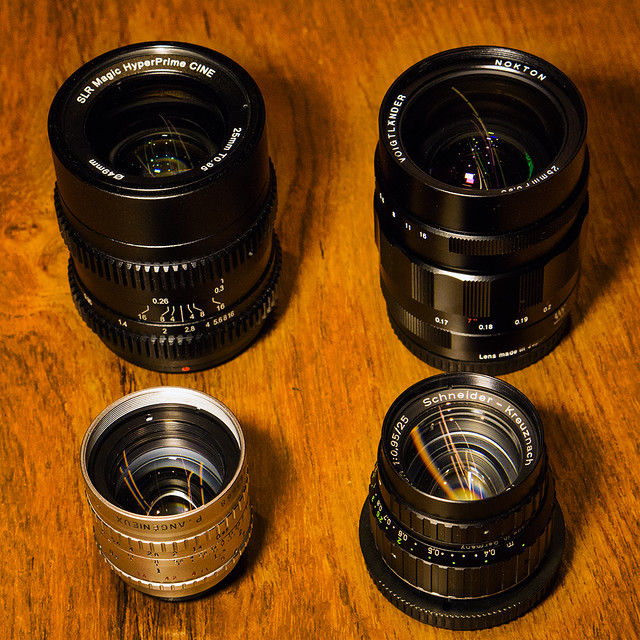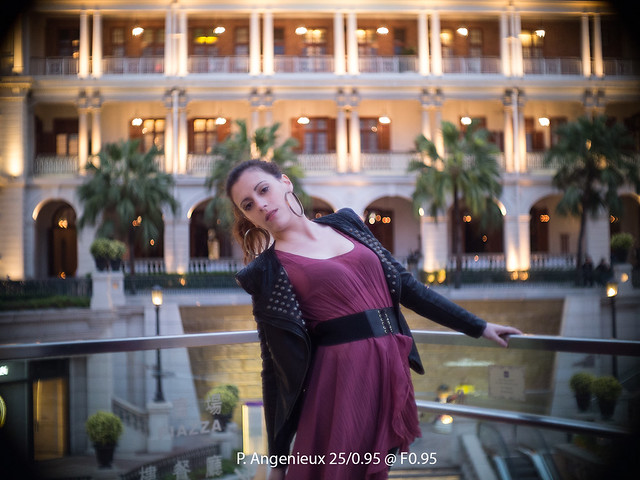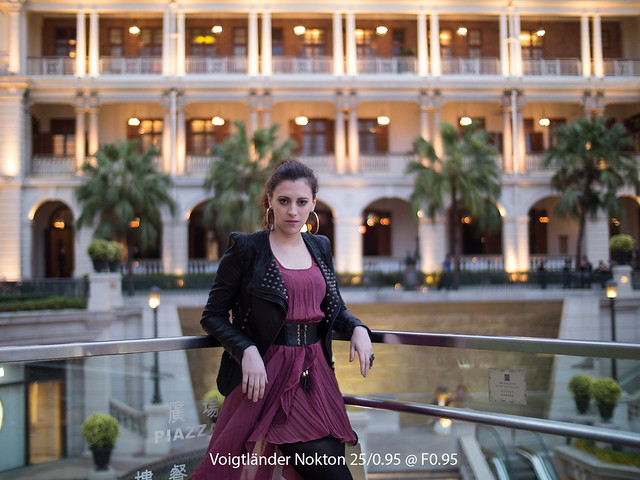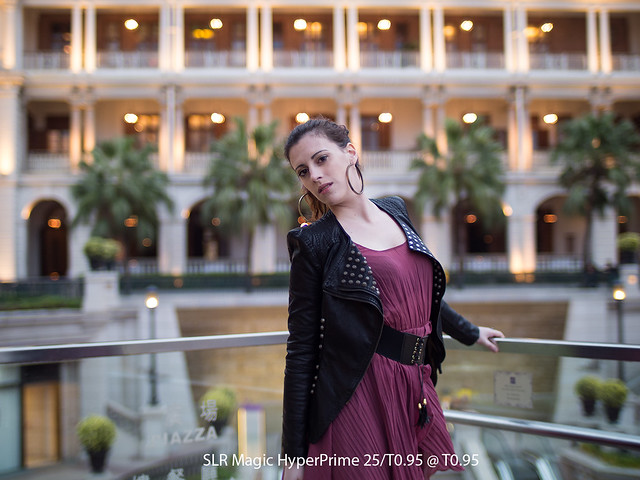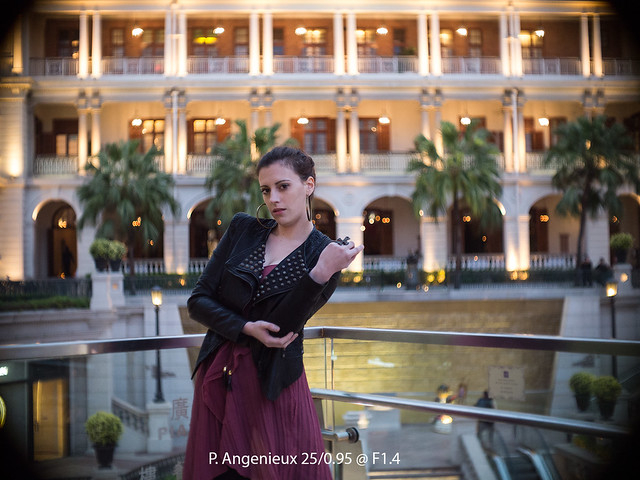28 Feb. 2013 - Last week was one of the highlights of my trip through Southeast Asia as I had the chance and pleasure to compare the upcoming SLR Magic HyperPrime CINE 25mm T0.95 to three other highly adorable, wide open 25mm F0.95 lenses. Let us see how they perform on the latest mFT camera, the Lumix GH3!
This little shootout was more a kind of spontaneous incident as we had some daylight remaining at the end of an "Adorable 35s" session planned for that day in Hong Kong with Andrew Chan and some friends. Andrew is the driving force of SLR Magic and very passionate about great lenses - not only those he builds by himself. But let me state that I am not affiliated with SLR Magic and payed for all lenses I got from them. We got some kind support from Bertille Tabourot, who is a stylist and fashion designer from France, living currently in Hong Kong. For this comparison shooting she took the chance to present one of her fancy creations acting as a freelance model.
But now let's talk about the principal performers of this shootout ordered by "age":
- P. Angenieux Paris 25mm Type M1 f/0.95
This very compact and beautyful lens was developed in 1953 and at that time the fastest 25mm design. One of the early copies was used by NASA to take the first photographs of the moon from a lunar probe. It is said to have a very cinematic look, a nice bokeh when used wide open and sharp look when stopped down. It is quite hard to find and prices may be around 1500 US$ when in good condition. - Schneider-Kreuznach Xenon 25mm F/0.95
Schneider Xenon designs have their origin already in 1925 when Tronnier derived it as an asymmetrical derivative of the classical double-Gauss design. The Xenon 25mm f/0.95 became available in the 1960s. The particular copy used in this test was manufactured in late 1978 or 1979 and was equipped with a built-in center spot ND filter that could be ordered for special applications. Current versions do not have that filter and look a bit different, see here. Used prices will vary between 800 and 1500 US$ depending on condition and type. - Voigtländer Nokton 25mm f/0.95
This lens was developed by Cosina Voigtlander and became available for the MicroFourThirds mount in 2010. It is known to be already pretty sharp wide open with increased sharpness when stopped down to F1.4 to F2.0. Price is about 1200 US$. - SLR Magic HyperPrime CINE 25mm T0.95
Production version will become likely available in April 2013 and will start at a price of 799 US$. It has cinema lens gears and aperture keeps round even when stopped down. In this comparison we used a pre-production (step 2) sample. For a rating of sharpness and bokeh please see my conclusion at the end of this article.
Overall Picture Comparison (F0.95 / T0.95)
The following pictures were all shot from the same postion between 6:19 and 6:27 p.m. on a cloudy day already after sunset in order to get a nice light mood with some point shaped highlights in the background. To avoid motion blur, exposure times were kept at 1/125s which results in ISO settings already between 400 and 1000 (due to differences in transmission/vignetting and sligthly dimming light) and of course we used a tripod.
Let us start with the Angenieux 25/0.95 at open aperture:
You may determine already from the downsized resolution that the model is rendered with a "dreamy glow" and the background has a nice and creamy out-of-focus blur (you can see higher resolutions when you click on the image). The lens produces some geometric distortion and vignettes already quite strong on mFT sensors. These characteristics are propably the reason why some people tend to say this lens produces a very cinematic look.
The following image was taken with the Schneider-Kreuznach Xenon 25/0.95 at open aperture:
In this example the model is rendered very sharp but I still miss some "pop" as the out-of-focus portions of the background attract too much attention with swirly patterns. Vignetting and distortion are quite obvious but a bit less compared to the Angenieux.
Next image shows how the Voigtlander Nokton 25/0.95 renders this scene at open aperture:
Compared to the previous examples you will recoginze a significant increase in overall image quality. The model is rendered with adequate sharpness, the background blur looks smooth enough and there is only a little vignetting and distortion.
Last but not least the image from the SLR Magic HyperPrime CINE 25mm T0.95 at open aperture:
The model is rendered already very sharp with more "pop" at open aperture whereas the out-of-focus portions of the background are rendered significantly smoother and creamier than with the other lenses already at this downsized resolution. Vignetting and distortion are almost invisible which lets me speculate that the usable image circle might be significantly larger than what a FourThirds sized sensor requires.
Bokeh Comparison (F0.95 / T0.95)
Now let us take a closer look to the "bokeh" - the way how the lenses render the out-of-focus areas in the background and the shape of the circles of confusion (CoC) that punctual highlights produce out there.
100% crop (actual pixels) from the picture taken with the Angenieux 25/0.95 at open aperture:
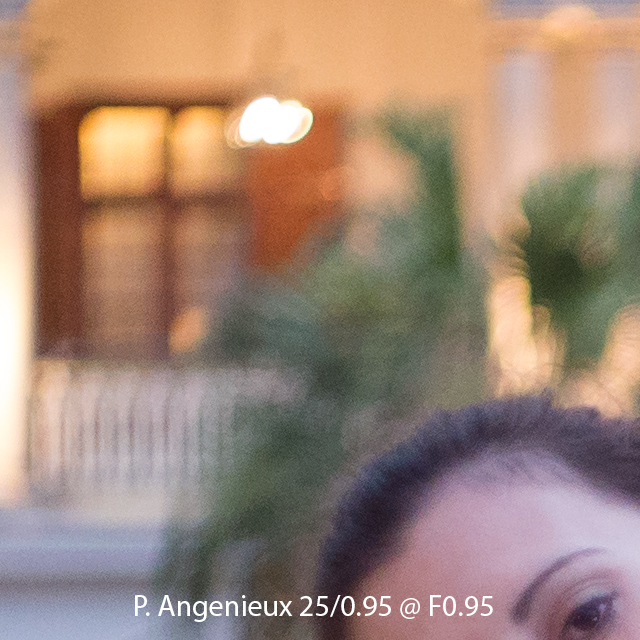
100% crop (actual pixels) from the picture taken with the Schneider-Kreuznach Xenon 25/0.95 at open aperture:
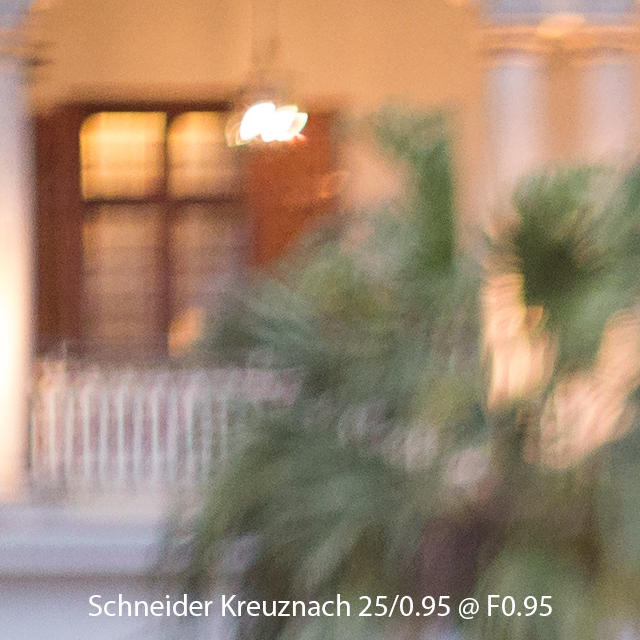
100% crop (actual pixels) from the picture taken with the Voigtlander Nokton 25/0.95 at open aperture:
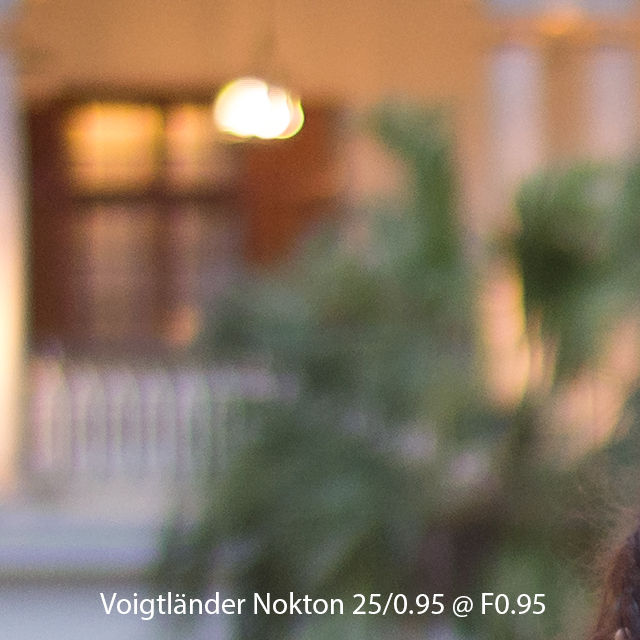
100% crop (actual pixels) from the picture taken with the SLR Magic HyperPrime CINE 25/T0.95 at open aperture:
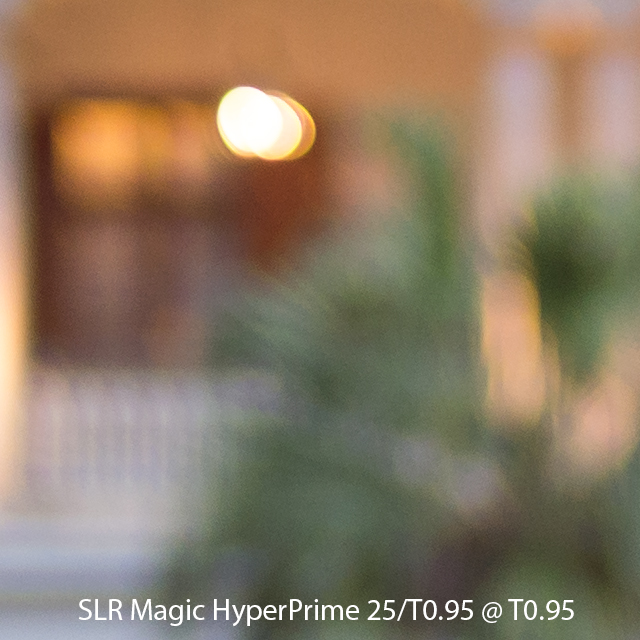
As aroused already in suspicion from the overall views: The SLR Magic HyperPrime renders the out-of-focus background to the smoothest degree and produces very neutral circles of confusion - simply close to perfection. The Voigtlander Nokton tends to be a bit more nervous in the out of focus areas and depending on the distance from the center, the circles of confusion get more and more deformed but all in all it produces still a fairly nice bokeh. The bokeh of the Angenieux is quite nice as well and of course has a very unique character. For my taste the Schneider-Kreuznach fails regarding bokeh quality. It is very swirly and the circles of confusion are something that does not remind me on circles anymore - but be aware: the shots were taken with the version with integrated spotfilter. Bokeh of the version without spot filter looks a bit different.
Sharpness (F0.95 / T0.95)
Due to the changing lighting conditions after sunset, different transmission and vignetting of the lenses, as a result we got differences in the ISO amplifications choosed by the camera. Also the model changed it's position slightly during the shooting. So all in all not perfect prerequisites for a precise sharpness comparison and of course the primariliy intention of the shots is NOT to be used as a reference for direct sharpness comparisons between the lens samples. But you still can get an idea about their performance and pay attention to some special characteristics of the circles of confusion in the center area as well:
100% crop (actual view) from a picture shot with the Angenieux 25/0.95 at open aperture:
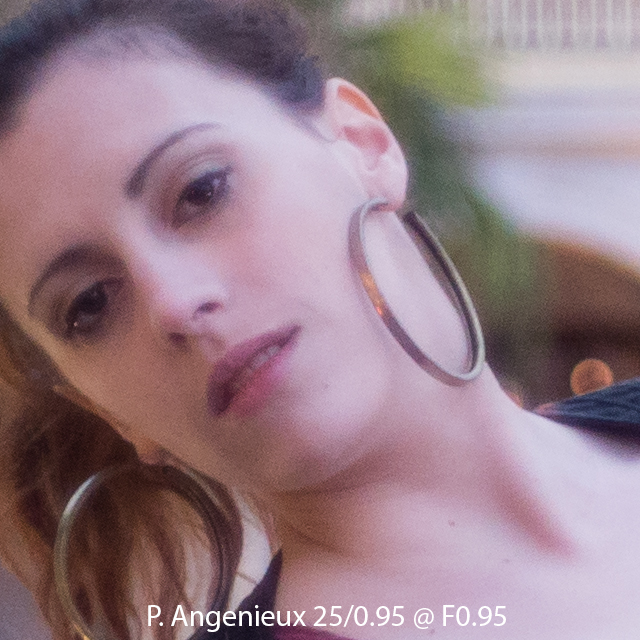
100% crop (actual view) from a picture shot with the Schneider-Kreuznach Xenon 25/0.95 at open aperture:

100% crop (actual view) from a picture shot with the Voigtlander Nokton 25/0.95 at open aperture:
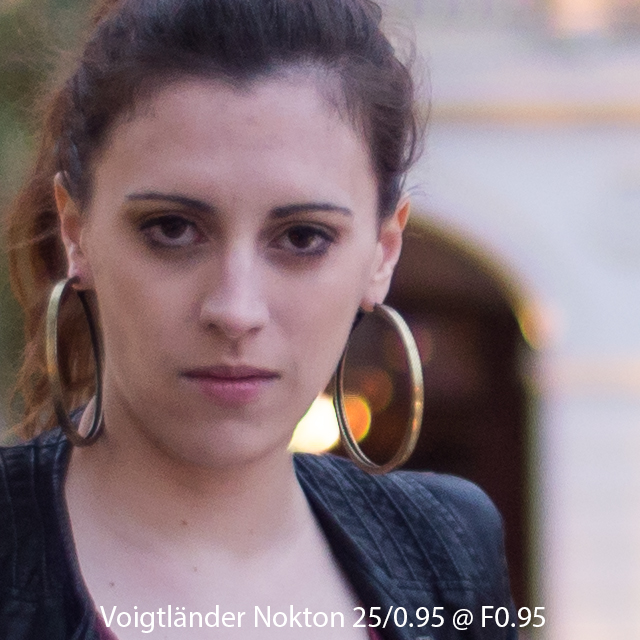
100% crop (actual view) from a picture shot with the SLR Magic HyperPrime CINE 25/T0.95 at open aperture:

From these samples the Voigtlander Nokton and the SLR Magic HyperPrime CINE are able to deliver good sharpness already at open aperture with a slight advantage to the HyperPrime that also shows the most neutral circles of confusion here. The Schneider-Kreuznach is extremely sharp already at F0.95 but with another deduction for the dark spots in the circles of confusion ("donuts") caused by the built-in ND spotfilter. Again let me remind you that shots taken with a version without spotfilter will look different regarding this aspect.
The Angenieux is significantly softer, it needs to be stopped down to F2.0 in order to get comparable sharpness in the focused area. The model was standing about 3m away from the camera and as I mentioned already earlier, she slightly changed her position during the shots, so focus is not exaclty consistent throughout all shots. Nevertheless the impact on the out-of-focus rendering can be almost ignored. The circles of confusion in the center of the image have about the same size (e.g. about 60 pixel for the HyperPrime CINE and about 59 pixel for the Nokton).
...stopped down to F1.4 / T1.4
You may be interested as well in a short comparison when the lenses are stopped down to F1.4 / T1.4.
Overall comparison (click on images for other sizes):
...and the 100% crops (actual pixels):
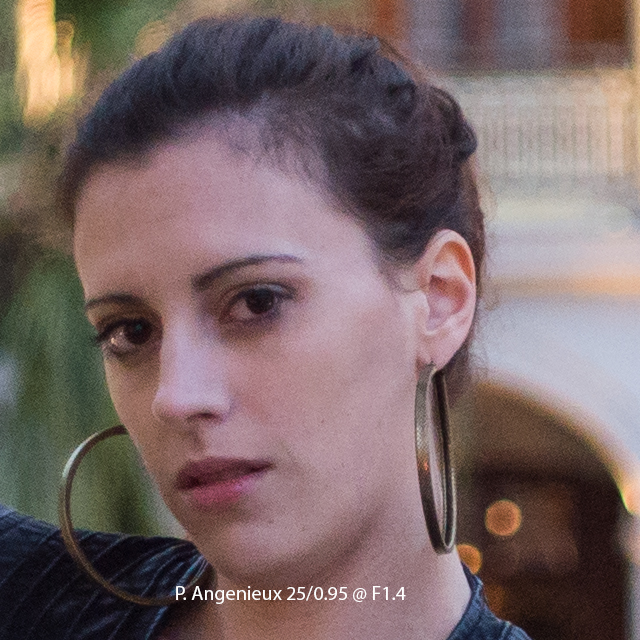

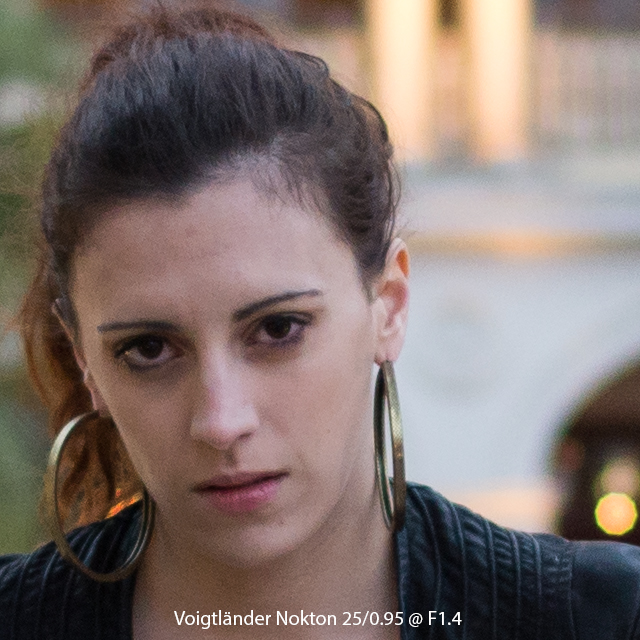
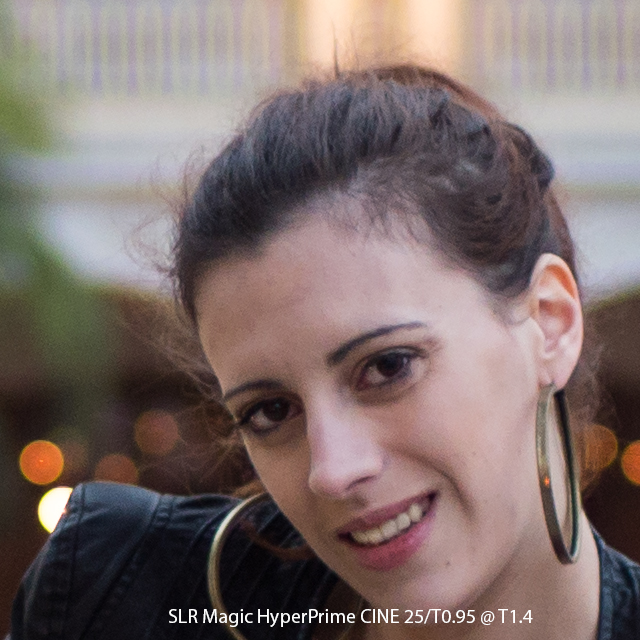
Notably that stopped down, the aperture blades of the SLR Magic HyperPrime CINE still keep a round shape - and so the circles of confusion whereas you can count already the number of aperture blades of the other lenses. Sharpness becomes comparable to all but the P.Angenieux (which is getting closer regarding sharpness to the others as far as these light conditions and already high ISO settings allow to compare) and the bokeh of the Schneider-Kreuznach is getting less swirly when stopped down.
Conclusion
Already in 2010 the Voigtlander Nokton 25/0.95 demonstrated, which advantage in image quality can be gained for mFT sensor cameras with a modern and more complex lens design implemented with high quality glass and coatings but at the price of less compactness. The SLR HyperPrime CINE 25mm T0.95 at about the same size and weight shows imposingly that sharpness as well as bokeh quality at F0.95 (in fact the HyperPrime CINE provides an aperture of about F0.9 in order to allow a transmission of T0.95) could be even more optimized at a very attractive price.
If you prefer extreme center sharpness (for the price of a swirly bokeh with dark spots in the circles of confusion) from the Schneider-Kreuznach or a very characterful cinematic look with stronger vignetting at maximum compactness from the P.Angenieux, the two classic designs may still be an interesting alternative.
Andrew Chan from SLR Magic explained to me that the lens used in this comparison still was a pre production assembly (step 2). The final production version has been fine tuned for even more sharpness by reducing purple fringing / chromatic abberation to a lower degree.
References / additional information:
If you are interested to learn more about Andrew Chan's passion for lenses, I recommend reading this interview: http://japancamerahunter.com/2013/02/insider-interview-andrew-chan-of-slrmagic/
HyperPrime lenses can be ordered at http://www.slrmagic.com/products.php. If you do not find the lens you are interested in, simply contact support (at) slrmagic.com by e-mail.
Background information about Voigtländer lenses: http://en.wikipedia.org/wiki/Voigtl%C3%A4nder
Background information about Schneider-Kreuznach: http://en.wikipedia.org/wiki/Schneider_Kreuznach
Background information about P. Angenieux: http://en.wikipedia.org/wiki/Pierre_Ang%C3%A9nieux
The facebook homepage of the stylist Bertille Tabourot supporting this comparison as a freelance model can be found here: http://www.facebook.com/BertilleTabourot
All images copyright by 3D-Kraft.com.




